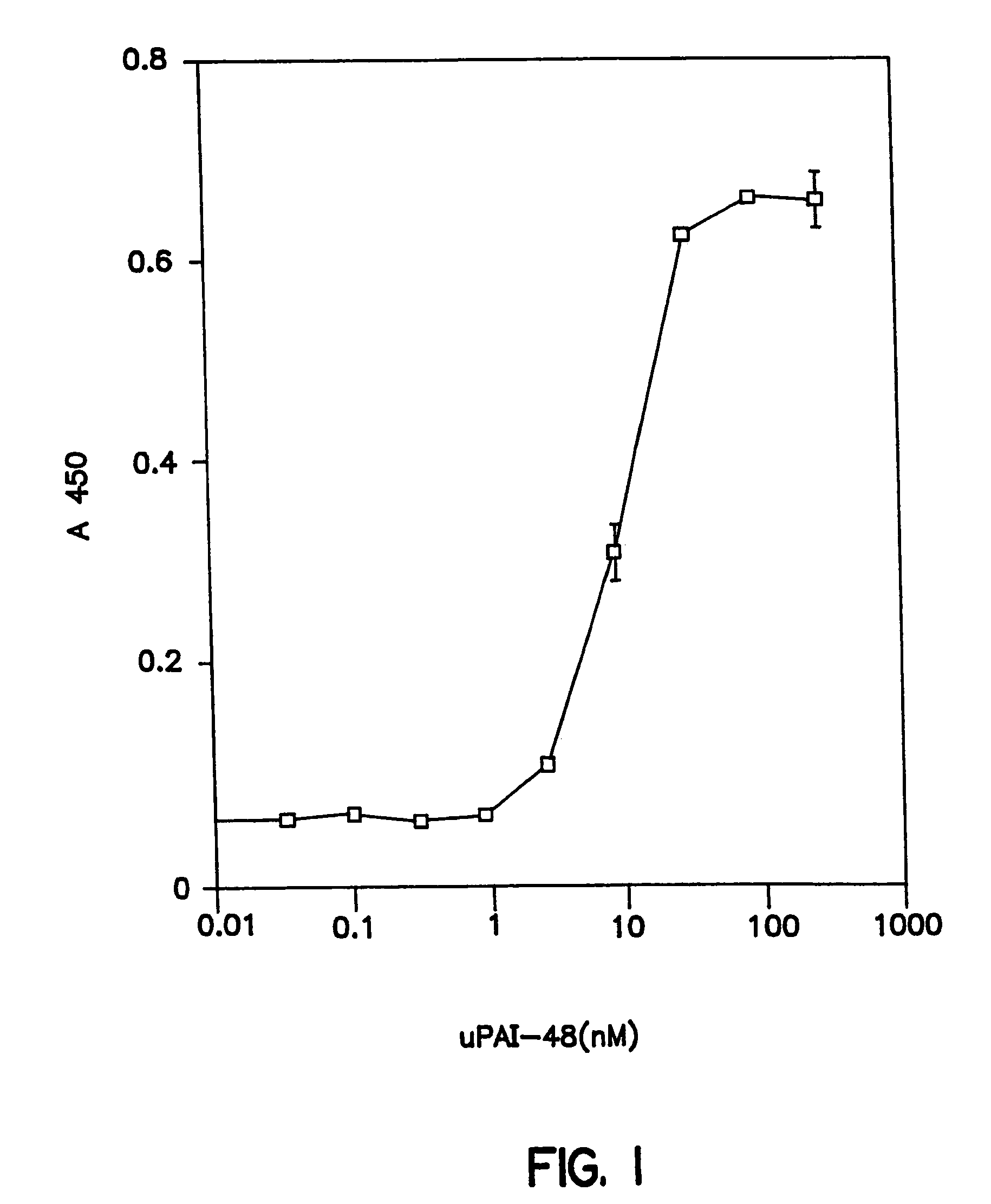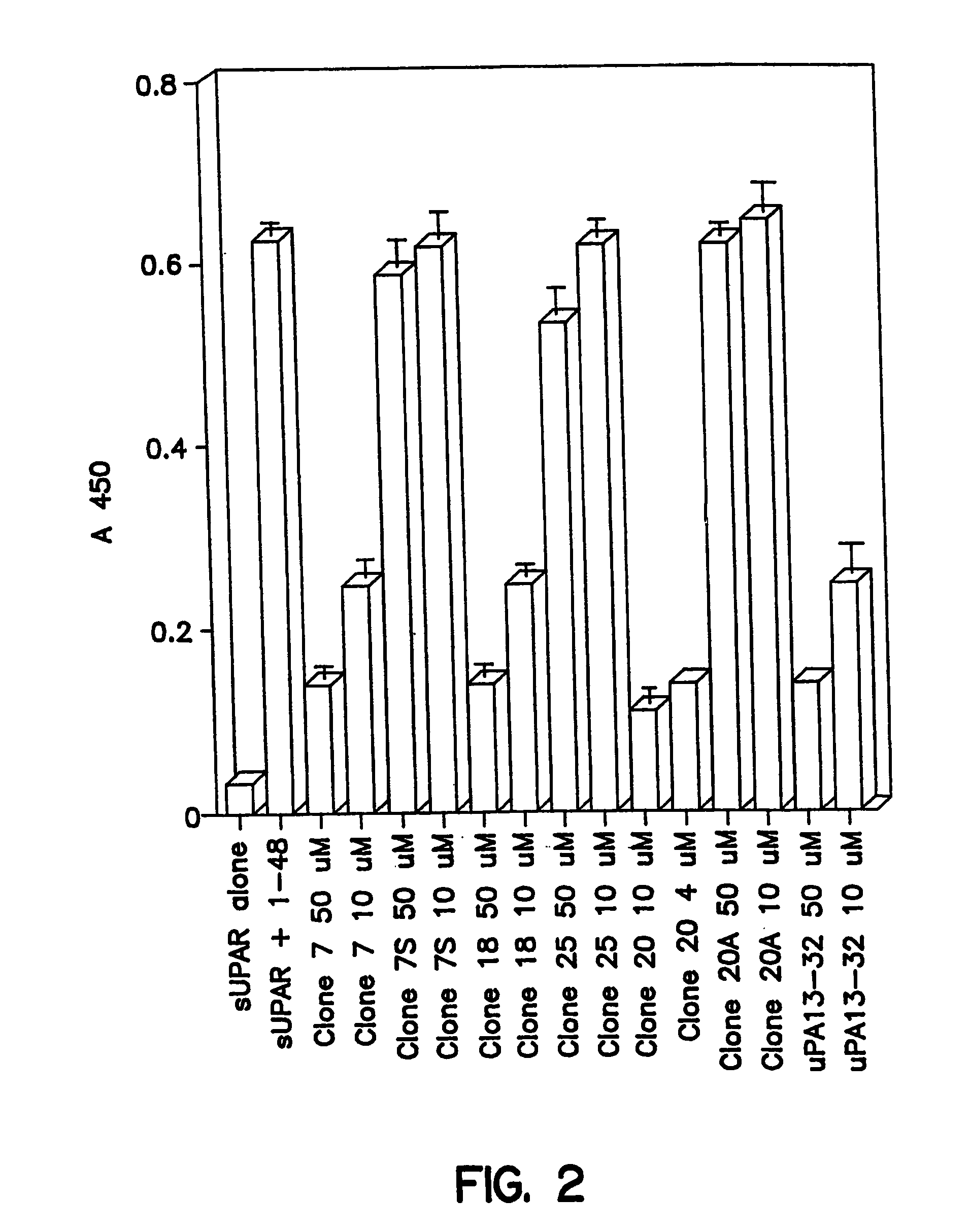Peptide ligands of the urokinase receptor
a technology of urokinase and ligands, which is applied in the field of peptide ligands of the urokinase receptor, can solve the problems of inability to distinguish whether domain 2 and 3 has measurable affinity, and achieve the effect of reducing the number of ligands
- Summary
- Abstract
- Description
- Claims
- Application Information
AI Technical Summary
Benefits of technology
Problems solved by technology
Method used
Image
Examples
example 1
Affinity Selection of 15 mer Random Peptide Library on uPAR:uPA1–48 Complexes
[0130]Soluble recombinant human urokinase receptor (suPAR) was expressed and secreted from baculovirus-infected Sf9 insect cells, as described in Goodson et al.,
[0131]Proc. Natl. Acad.Sci.USA 91:7129–7133 (1994). The EGF-like domain of human urokinase (uPA residues 1–48) was expressed from recombinant yeast as described Stratton-Thomas et al., Prot.Eng. 8: 463–470 (1995). UPA1–48 was purified by a revision of the published procedure, involving ion exchange chromatography and reverse phase HPLC under reducing conditions, followed by a refolding step and rechromatography on reversed phase HPLC of the oxidized material. Soluble uPAR was purified on a column of immobilized uPA1–48, eluted at low pH, biotinylated according to Kaufman et al. Anal. Biochem. 211:261–266 (1993) and purified on a Soft-Avidin column (Promega Corporation, Madison, Wis.). The uPAR fragment encompassing domains 2 and 3 (amino acids 93–31...
example 2
Bacteriophaae Binding to sUPAR
[0133]Streptavidin, 100 μl (0.1 mg / ml) in 50 mM Na2CO3, pH 9.6, was added to MaxiSorp wells (Nunc), incubated overnight at 4 C, and then washed with PBS / BSA. Biotinylated sUPAR (25 nM in PBS / BSA) was added to the wells and incubated for 2 hours at room temperature prior to washing. Competitive peptide inhibitors were added to the wells immediately prior to addition of the bacteriophage. The wells were incubated for one hour at room temperature, then washed and bound bacteriophage eluted with 6M urea in 0.1N HCl, pH 2.5. After 15 minutes, the urea eluate was brought to neutral pH by addition of 2M Tris base and the bacteriophage titers of input stocks and elutions measured by plaque formation assay. Results were expressed as the percent of input bacteriophage which bind to the wells. Alternatively, the amount of bacteriophage was determined in an ELISA where phage were preincubated with HRP-conjugated anti-M13 antibody for 30 minutes at room temperature ...
example 3
Vitronectin Binding Assay
[0138]Vitronectin was purified from human plasma by the method of Yatohgo et al, Cello Struct.and Funct. 13: 281–292 (1988). Purified vitronectin was diluted to 20 μg / ml in PBS containing 1 mM CaCl2 and 0.5 mM MgCl2, dispensed at 50 μl / well into Immulon II wells (Dynatech, Chantilly, Va.), incubated overnight at 4° C. and washed with PBS / BSA. Biotinylated sUPAR was diluted to 20 nM in PBS / BSA, incubated with or without test ligand for 30 minutes at room temperature (22° C.), dispensed at 100 μl / well and incubated for 90 minutes. Wells were then washed and horseradish peroxidase (HRP)-conjugated streptavidin was added at 0.4 μg / ml in PBS / 2% BSA for 1 hour followed by washing and addition of 100 μl / well TMB substrate. The color development was stopped with 100 μl of 0.8N H2SO4 and the absorbance at 450 nm measured in a 96 well plate reader (Dynatech, Chantilly, Va.). Antagonistic effects of test ligands were measured as described above except the ligands were ...
PUM
 Login to View More
Login to View More Abstract
Description
Claims
Application Information
 Login to View More
Login to View More - R&D
- Intellectual Property
- Life Sciences
- Materials
- Tech Scout
- Unparalleled Data Quality
- Higher Quality Content
- 60% Fewer Hallucinations
Browse by: Latest US Patents, China's latest patents, Technical Efficacy Thesaurus, Application Domain, Technology Topic, Popular Technical Reports.
© 2025 PatSnap. All rights reserved.Legal|Privacy policy|Modern Slavery Act Transparency Statement|Sitemap|About US| Contact US: help@patsnap.com



